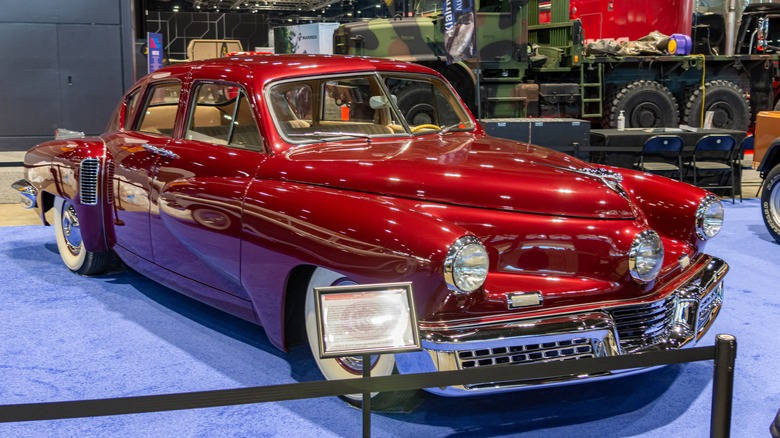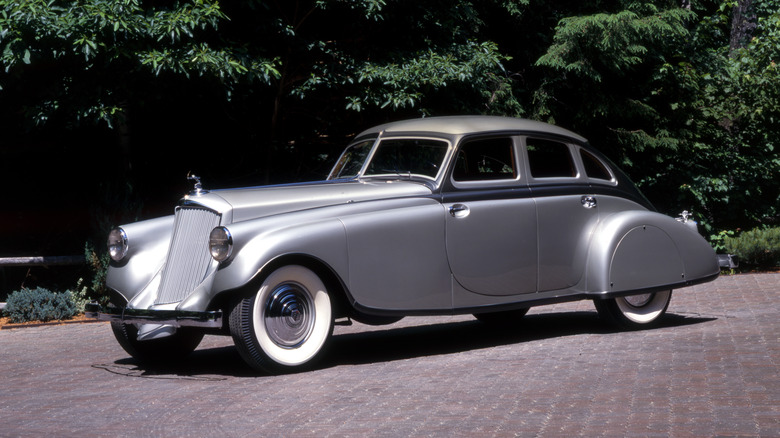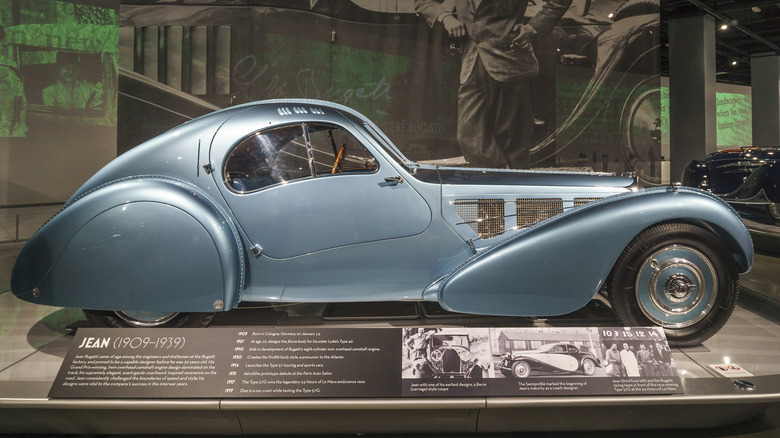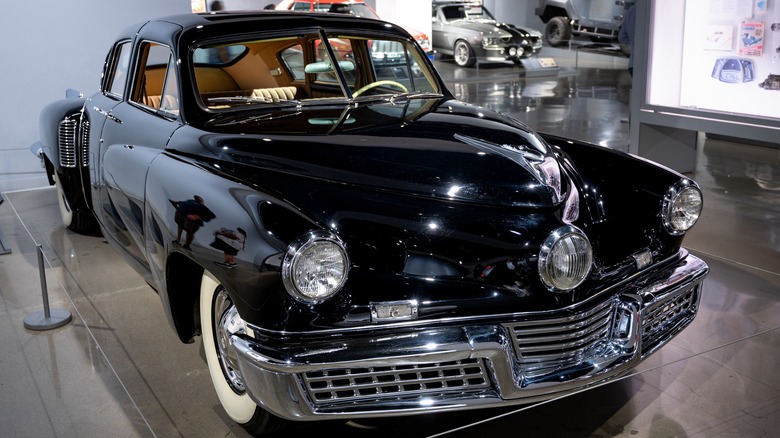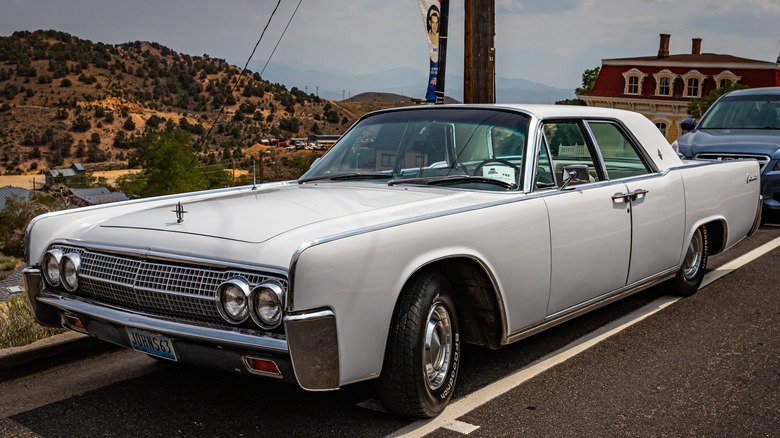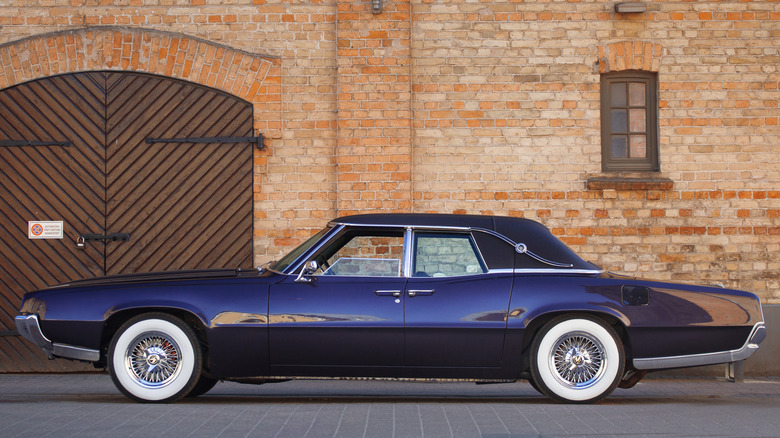5 Of The Coolest Classic Cars With Suicide Doors
When it comes to vehicle features, few have names as eye catching as "suicide doors." The doors, which are hinged backward and open the opposite way to a standard door, are a bold stylistic choice that can add a touch of elegance (and arguably a sense of danger) to a vehicle. If you're wondering why they're called suicide doors, the answer is simple: the name is based on the perceived danger that comes with hinging a door at the back. If said door is a bit heavy — and a malfunction happens that causes the door to swing open — grabbing the handle in an attempt to close it could result in a driver or passenger being yanked out of the moving car and onto the road. If this were to happen, the door in question is also likely to hit them and ultimately see them off.
While door latch malfunctions aren't unheard of, death isn't really a guarantee with suicide doors. A seat belt would prevent the door from yanking you out of the vehicle for a start, and letting go of the door handle would also be likely to save you. Manufacturers tend to dislike the term suicide doors due to its negative connotations, preferring the term "coach doors" instead. While uncommon, the configuration does still crop up from time to time — especially on higher-end vehicles like the Rolls-Royce Spectre. As the polite term coach doors suggests, the configuration dates back to a time when horsepower came from literal horses, so you can find the doors on vehicles over a century old if you look hard enough. Here's a selection of our favorite classics that sport a set of suicide doors.
1933 Pierce-Arrow Silver Arrow
Pierce-Arrow isn't a well known automaker these days, but back in the 1930s, it was one of the three main American luxury automotive manufacturers — one that was acquired by Studebaker. The Silver Arrow was one of the marque's standout offerings from the mid-1930s. The Silver Arrow was pretty tech-packed for its time, featuring things like power-assisted brakes and an automatic clutch. The 139-inch wheelbase smoothed out the ride. Add in a sweeping roof and coachbuilt interior, and you have an almost perfect example of the kind of luxury that contrasted against the Great Depression back in the 1930s. It also has suicide doors, which fits fantastically with the overall aesthetic.
The suicide doors sit at the front of this four-door vehicle, which could be considered a strange choice but may point toward the Silver Arrow being seen as a driver's car rather than something a chauffeur takes you around in. The original Silver Arrow is still around and was sold for over $2.3 million by RM Sotheby's back in 2017. Given the upwards trend in the price of classics since then, it's safe to assume this beauty from the 1930s is worth a lot more now.
Bugatti Atlantic
These days, Bugatti is best known for its hypercars that combine high-end interiors with often record-breaking speeds. Despite that, the French automaker has a history stretching back over 100 years, and its earlier models were the kind of coachbuilt classics you're likely to associate with the 1930s. The Bugatti Atlantic (one of the more expensive models in Ralph Lauren's collection) is arguably the most pure version of this, with a coupe configuration, large arching fenders, and a hood longer than the Atlantic itself.
The vehicle was also equipped with coach doors, which add a lot to the overall aesthetic. As you may expect, the Bugatti Atlantic is an exceedingly rare car. Only four were manufactured between 1936 and 1938, and the second vehicle in the run disappeared shortly after it was built. Rumor has it the vehicle was built for the company founder's son, Jean Bugatti. Bugatti allegedly hid the black Atlantic, known as "La Voiture Noire," when Nazi Germany invaded France. It hasn't been seen since. If someone did stumble across the legendary vehicle, experts predict it could sell for as much as $104 million — which would make it one of the most expensive cars ever sold.
Tucker 48/Torpedo
The Tucker 48, which is often referred to as the "Tucker Torpedo," first hit the road in the years following World War 2. Contrary to the reputation that surrounds suicide doors, the Tucker was actually seen as a very safe vehicle. It had a central headlight that turned with the driver, a "shatterproof" windscreen designed to pop out on impact, and a safety chamber that a driver and passenger could throw themselves into should a collision be imminent. The interior also featured a lot of padding, though if you look at this through a modern lens you may question the efficacy of it all.
Arguably the most effective safety feature on the Tucker 48 is its built in roll cage which helped the cabin keep its form if the vehicle went for a tumble. The vehicle had other unique features too, including a pair of torque converters in place of a transmission. This had a few issues, including the lack of a reverse gear and a bit of a vague feeling until the torque converter fully engaged at around 30 mph. Still, it's another quirk of what is undoubtedly one of the most unique vehicles ever to go into production. Not surprisingly, the manufacturer slapped a set of suicide doors on there. What did you expect? Something normal?
1960s Lincoln Continental
Vintage Lincoln Continentals have a charm of their own. They're the sort of thing that makes you want to slap in a velvet interior, hang some furry dice from the mirror, and legally change your name to Huggy Bear (though he may have driven an Eldorado). The Continental is firmly in the "cruising in comfort" category of vintage vehicles. The 1960s was arguably the Continental's heyday, and suicide doors were a standout feature of the vehicles produced between 1961 and 1969.
Between the start of the decade and 1966, suicide doors were actually the only option for those who wanted a Continental. They were still standard between 1966 and 1969, but a coupe version was also available for those who wanted a more traditional type of door. It's fair to argue that the "suicide door Lincoln" is the most iconic variant of the Continental; it sticks in the brain so much that it even inspired a limited edition Lincoln back in 2019. The special edition model celebrated the Continental badge's 80th anniversary and was limited to 80 units.
1967 Ford Thunderbird
Ford's Thunderbird series of vehicles is one of the most iconic in American history, and the 1960s were arguably the vehicle's heyday. A combo of muscle-car looks, impressive power, and a touch more luxury made the T-bird an obvious choice for many. But the 1967 model year had one special feature that made it stand out from the rest.
The sedan's back doors were hinged the other way, so technically it came with suicide doors even if said doors weren't at the front. This configuration isn't exactly unique and still makes an appearance from time to time. The concept drawings for the Kia EV9 had coach doors at the back, before the reality of manufacturing a large vehicle without a central pillar set in. But none of the vehicles pull it off quite like the Thunderbird did.
So if you want a cool classic with suicide doors, then this late '60s effort from Ford is likely as good as it gets. Things may change in the near future as odd efforts from the likes of Spyker enter "classic territory," and in a couple of decades we may even be sticking the likes of the Ferrari Purosangue on this list. But for now, the 1967 T-Bird is likely the undisputed king when it comes to classics with this unconventional door configuration.
